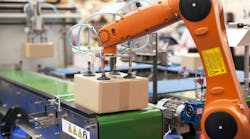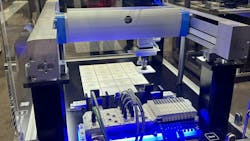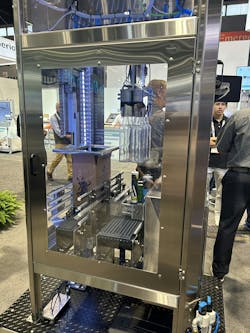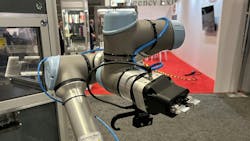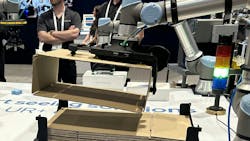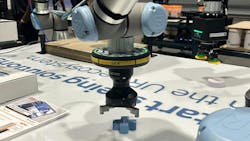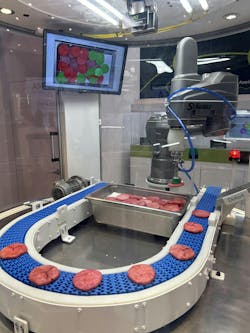The various ways pneumatics is utilized in packaging machinery applications was evident at PACK EXPO International 2024 — one of the largest events for the packaging and processing industry. Many of the pneumatic solutions displayed demonstrated the important role this motion control technology can play in automation.
Automated systems and machines are becoming increasingly important in the packaging sector, like many others, to help overcome the skilled labor shortage the industry is facing. Although many of these systems use electronic and electromechanical components, several rely on pneumatics as well.
Mark Walters, Industry Segment Sales Manager, Food & Packaging at Festo Corp., said electric automation is becoming more common as the technology advances and price point lowers but it is still an exponentially more expensive technology. And if wanting to do a simple task such as rotary actuation there is no benefit to electrifying that.
Pneumatics would be a better fit for such an application because it continues to be a cost-effective motion control option. “Pneumatics is never going away because it is a tried-and-true technology,” he said.
The low cost, longevity and speed capabilities offered by pneumatics have made them a common technology of choice in various manufacturing applications, including packaging machinery. And with the technological developments taking place in the pneumatics sector, their use will remain vital in these applications as they become more automated.
Pairing Pneumatics with Electronics Meets Varied Application Requirements
Walters said many automation applications call for using both pneumatics and electronics. Often an application needs the precision of placing an object in a specific spot, typically enabled by electronics, but may also require simplified motions to be undertaken which is feasible with pneumatics. “We’re able to combine both technologies,” he said.
He noted using a combination of pneumatic and electric motion control technologies is increasing in the market — for packaging and a range of other machinery applications. By offering both technology types, Festo is better able to provide solutions which meet customer needs while offering a single source for such systems. “We understand your application, we’re sizing your system, we’re providing you a solution and you have one company to work with…we are seeing a lot of demand for that,” he said.
A good example of this at Festo’s PACK EXPO booth was a case packer from the company’s customer CODI Manufacturing. The gantry system and axis utilized in the case packer are electric, but pneumatics is employed as well for aspects such as the grippers and belt manifold.
Walters said the machine would be twice the cost if the customer had gone all electric. By instead combining electric and pneumatic motion control solutions, the case packer is able to provide the precise automation capabilities desired at a cost-effective price point.
Integration of electronics into pneumatic components is increasing as well to make them faster, smarter and more efficient, which is what customers today are looking for from these motion control devices.
This was exemplified by many technologies Festo displayed at PACK EXPO 2024 such as its motion terminal. The terminal has a built-in controller which Walters said enables things to be done with pneumatics that were not possible before such as position control similar to that normally achieved with a servo solution.
“Having that is unique to pneumatics,” he said. Developing such a technology “helps pneumatics stay relevant in the market because now it’s intelligent.”
Walters said there are some larger companies de-emphasizing their use of pneumatics due to energy conservation efforts, but that there will always be an environment for the use of this motion control technology. Pneumatics is a proven technology that fits the needs of many applications, and with the advancements taking place in the sector — such as the incorporation of electronics into pneumatics — it is better able to meet the improved energy efficiency requirements of machine OEMs and their customers.
Pneumatics Important Component of Robotics Operation
Probably one of the most evident uses of pneumatics in packaging and other manufacturing applications is in robots. The technology is commonly utilized for grippers, vacuum and other end of arm tooling (EOAT) but can also be used to press components together and for painting, among other use cases.
Advancements continue to be made in EOAT, as demonstrated at PACK EXPO 2024 by companies such as Camozzi Automation which showed its recently introduced Series CSSP pneumatic collaborative parallel gripper. The gripper has all valves and other components built into it and requires just one air line to provide a compact as well as efficient option for various robotic applications.
For its cobots employed in packaging applications, Universal Robots (UR) typically uses a mix of pneumatic and electromechanical technologies. As Adam Boike, Global Application Engineer for Universal Robots, explained, UR uses pneumatics for the tooling mounted at the end of the robot which interfaces with products. Electromechanical systems are used for the motion of the robot as it typically requires more precision than you would get from pneumatics.
Given EOAT plays an important role in the operation of a robot, UR showed the various options it offers including those developed by partner companies through its UR+ Ecosystem at PACK EXPO. These companies have developed pneumatic and electromechanical EOAT solutions designed to offer end users a plug-and-play option that works with various robots from UR — making setup and installation easier, increasingly important with the skilled labor shortage facing so many manufacturers.
Boike said UR often uses vacuum technology for the EOAT on its robots, and as such showed a range of options at its booth.
Among these was one developed by Schmalz which has an electric motor inside which generates a vacuum. He said this eliminates the need to run a vacuum line along a robot arm, helping to create a more simplified solution for end users.
Other vacuum end effectors from technology partners on display demonstrated the various ways they could be utilized, such as the box folding gripper from Impaqt Robotics. It is designed to pick up flat boxes and fold them; a secondary process is used to tape and fold the flaps in explained Boike.
And like many other EOAT, the gripper features a single tube air inlet to provide a compact design that is easy to install on a robot. This helps to reduce system complexity and space requirements which are becoming more constrained. Reducing the amount of tubing required also minimizes potential safety hazards from the workspace.
A new EOAT option UR highlighted at PACK EXPO is called the End of Arm Safeguard developed by SICK. Using lidar sensor technology, it creates a sort of dome around the gripper so if someone reaches toward the robot or puts their hand near the gripper while it is actuating, the system will stop the robot arm. This helps to add an extra layer of safety to various robotic applications.
Vision Systems Work Together with Pneumatics to Improve Safety and Productivity
Vision systems have become an important element of machine automation as they can be used to detect objects of various types. Doing so enables information to be fed to other machine systems, including pneumatic EOAT on a robot, to inform the tasks which need to be performed such as picking up an object and placing it in the correct spot.
Oxipital AI explained that its vision technology can help developers of pneumatic EOAT components increase their tech efficacy because of the 2D and 3D data it can provide to the robot which in turn impacts how the pneumatic components will grip or pick up an object.
At its PACK EXPO booth, the company demonstrated how its new VX2 Vision System — combining high resolution 2D and 3D cameras with artificial intelligence (AI) — works with robotic picking systems to help sort between good and defective products.
In the demonstration, burgers moved along a conveyor. As they did so, Oxipital AI’s technology captured visual information about the burgers to determine which were good and which were defective. This information was then sent to a robotic arm equipped with a vacuum cup EOAT to help it sort the burgers; the good burgers were picked up and placed into one bin and the defective ones into another bin.
Technology like this helps to speed up the process of sorting and placing goods, reducing the chances of defective goods entering the market. According to a recent state of the industry report from PMMI, The Association for Packaging and Processing Technologies and organizer of PACK EXPO, significant investment is being made in such technologies to mitigate safety and recall issues which have been on the rise recently.
Oxipital AI also offers a version of its visual system which can be tied directly into a pneumatic soft gripper technology from Schmalz. A control module is used to communicate information directly to a robot and the Schmalz gripper at the same time. This enables the gripper to modify its grip as needed for the object at hand.
As Oxipital AI explained, if the object to be picked up was more amorphic in shape such as a chicken breast, its AI technology could analyze and inform the Schmalz tool what the best gripper position is to grab the chicken. The robot also receives this information so that it understands the best location and position for picking up the item based on its shape and volume.
Dynamic opening and closing of the gripper is possible as well, enabling it to be opened just enough for the given application each and every time it is used which can help to improve productivity for an operation.
Watch the video below from Schmalz of its pneumatic finger gripper which can be paired with the Oxipital AI vision system.
The pairing of vacuum and software technologies like this has become the way to work in the food and beverage space especially noted Oxipital AI. Vacuum or soft grippers are better able to provide the delicate touch required of many products, such as meat and breads. They also need to be able to adapt to various shapes, which the software enables.
In addition, it can be difficult to fit automation equipment into existing facilities as they often take up more space than might be available. But use of vision technology and smart grippers can make it easier to bring in automation as the systems are more adaptable to the varied types of goods which may be moving through a production line.
Creation of smart pneumatics technologies like this, and the many others demonstrated at PACK EXPO 2024, demonstrate the advancements taking place in this segment of the fluid power industry. This is helping it to remain a valuable method of motion control for automated systems in packaging and a number of other machinery applications.
